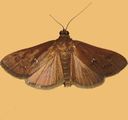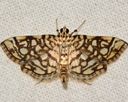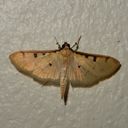Spilomelinae
Spilomelinae
Classification
- Phylum: Arthropoda
- Subphylum: Hexapoda
- Class: Insecta
- Order: Lepidoptera
- Superfamily: Pyraloidea
- Family: Crambidae
- Subfamily: Spilomelinae
Pronunciation
How to pronounce Spilomelinae: /ˌspaɪloʊˈmɛlɪˌnaɪ/
These audio files are automatically generated. While they are not always 100% accurate, they are a good starting point.
Images






Summary
Spilomelinae is a highly diverse subfamily of crambid moths, known for their wide range of host plants and economic significance due to several pest species. They exhibit a variety of physical characteristics and ecological roles in their environments.
Physical Characteristics
Imagines vary in size with forewing spans ranging from 11.5 mm to 50 mm. Moths are generally triangular in resting position with folded wings. They possess well-developed compound eyes, antennae, and mouthparts, although some genera lack a proboscis.
Identification Tips
Look for the characteristic triangular shape in resting position and the variation in forewing size. Check for the presence of maxillary palpi and specific genital structures for identification within genera.
Habitat
Spilomelinae can be found in diverse habitats, often associated with their food plants which range from ferns and gymnosperms to various angiosperms.
Distribution
Over 4,135 described species in 344 genera worldwide, with 244 species in 90 genera found in specific areas studied.
Diet
Larvae are known to feed on a wide variety of plants, including ferns, gymnosperms, and angiosperms. Some tribes have a narrow food spectrum, such as Lineodini on Solanaceae and Hydririni on Sapindaceae and Convolvulaceae.
Life Cycle
The full life cycle details are not explicitly stated, but generally includes egg, larval, pupal, and adult stages typical of moths.
Reproduction
Reproductive specifics were not detailed, but typically, moths exhibit various mating strategies and oviposition behaviors in relation to their host plants.
Ecosystem Role
As herbivores, larvae may play a role in controlling plant populations and can serve as food for various predators, thus contributing to the food web.
Economic Impact
Numerous species are considered pests, affecting economically important crops such as rice, maize, and various legumes. Significant genera include Leucinodes, Cnaphalocrocis, and the box tree moth Cydalima perspectalis, which has been introduced to Europe and North America.
Collecting Methods
- Light trapping
- Netting during flight periods
- Larvae collection from host plants
Preservation Methods
- Pinning specimens
- Ethanol preservation for larvae
- Drying in silica gel
Evolution
Spilomelinae was previously treated as a tribe within Pyraustinae until its recognition as a distinct subfamily based on phylogenetic studies.
Similar Taxa
Misconceptions
Some groups within Spilomelinae were once thought to be polyphyletic but were later found to be monophyletic in recent studies.
Tags
- Moths
- Lepidoptera
- Crambidae
- Spilomelinae
- Pest species